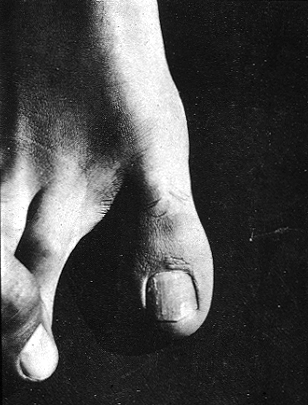Schwarz
View current page
...more recent posts

Jacques Andre Boiffard, Untitled, Big Toe series, for Documents, 1929
Attached to the choo-choo train of history the angelic aspect of Pollock's use of line was, for Clem, registered in the flight it could take, the statement it could make against the realm of matter and substance, and thus the sublimation it could perform.
I have been reading Rosalind Krauss' The Optical Unconscious (1993) and enjoying it very much. The above quote (from pg.290) made me laugh. Choo-choo train of history? Ouch! The way she argues with Clement Greenberg is highly charged. She's mean, and I suspect that was one way of getting through to the man, speaking his language. Of course, her arguments are not really addressed to Greenberg. Her goal isn't to convince him (she's not delusional), nor even, ultimately, to taunt him, but to assert her own paradigm for assessing works of modern art. Not only does she dissemble his theoretical positions with cogent argument, but she does so on his rhetorical terms. If one can talk of "owning" when it comes to shared cultural ideas, Greenberg is widely understood to "own" high modernism. But Krauss would beg to differ. Modernism isn't Greenberg, it's an historical era and Krauss has her own compelling version of events.
In the politics of art, she had helped Morris Louis' widow unroll his canvases, enjoyed a collaborative relationship with Kenneth Noland and was championed as an original by Clement Greenberg. Precisely because she worked so intensively and personally on her sculptures, Anne [Truitt] was dismissed by Minimalists such as Donald Judd for being too subjective (and, of course, too female) to create true "specific objects." Anne was deeply respectful of her dealer, Andre Emmerich, who criminally ignored her for a long time, giving her the occasional show, but little practical assistance.
In the studio, Anne was painstaking to a fault, finding the right piece of wood, sanding it for months to the point where it could properly absorb and reflect her chosen color and then applying layer upon layer of paint in order, counterintuitively, to achieve maximum transparency. The tiny bands of color at the base of her sculptures, which were subsequently borrowed by Haim Steinbach for his marvelous series of black paintings, were a clue to their meaning. There are two interpretive elements to Truitt's sculpture, a forbidding armor which blocks out the viewer at first glance and then a slowly revealed intimacy which invites further discovery.
little green men
10 houses made from unorthodox materials
via jbf
